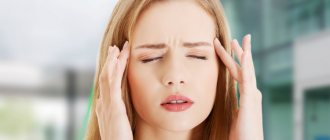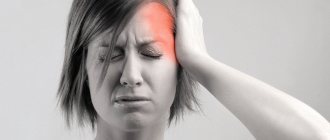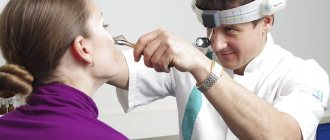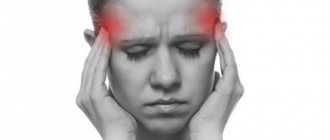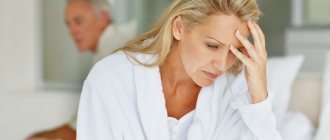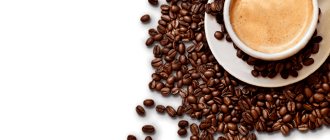Many people are familiar with the sharp pain that hits the left temple. This trouble can be a manifestation of a large number of different diseases, since a significant number of muscles, veins, nerve endings and receptors are located in the temporal region.
It happens that throbbing pain is the only symptom that worries a person. But sometimes other ailments are added to this problem. In any case, such symptoms cannot be ignored, since they may be signs of serious disorders in the body.
Mechanism of occurrence
Painful sensations occur due to irritation of the nerve trunks. First, a pathological impulse is formed in the nerve fibers, as a rule, this occurs due to some provoking factor, mechanical damage or inflammatory process affecting nerve processes or muscle tissue.
As a result, the pathological process affects the structure of neurons, and the nerve fibers cease to perform the function of “inhibition”.
As a result, a short-term pain impulse is formed that spreads throughout the entire nerve trunk. This is how a sharp pain arises, which is often accompanied by pulsation.
It is important to realize that pain in the temporal region of the head is not an independent disease, it is a concomitant symptom indicating some kind of disorder in the body.
How is throbbing pain formed?
Pain in the temporal areas has a pulsating nature due to several reasons. The vascular component plays a major role in shaping the nature of pain. Ripple occurs as a result of:
- Rapid reflex angospasm. The narrowing of the diameter of the cerebral arteries, in particular the temporal one, leads to a sharp increase in vascular pressure.
- Atherosclerotic changes in blood vessels lead to thickening of their walls and a significant loss of elasticity, which leads to the formation of a more rigid pulse wave.
Environmental factors can lead to spasm of cerebral vessels. and internal factors of the body. Stressful situations often act as a provocateur, which lead to the release of biologically active substances into the blood - catecholamines, which have a spasmodic effect and sharply increase blood pressure. Also, throbbing pain can appear as a result of a sharp temperature change, for example, if you go out into the cold without a hat in winter, a spasm of the cerebral arteries occurs, which causes throbbing pain in the temples.
Why it shoots in the left temple: 18 common reasons
If the left temple hurts and throbs, this may be a concomitant sign of a number of disorders. As a rule, trouble occurs under the following conditions:
- Physical and emotional fatigue . People who are stressed and lead an unhealthy lifestyle often experience headaches, and their face may go numb during an attack. As a rule, the painful condition lasts for 1–2 hours, after which improvement occurs.
. A situation where a headache and shooting in the left temple often occurs in adolescents and young women, especially during pregnancy. Often the malaise is accompanied by visual disturbances, and “spots” flash before the eyes, and some patients experience nausea, vomiting and an increased heart rate.
Migraine- Premenstrual syndrome . During these periods, neuroendocrine changes occur in a woman’s body, one of the manifestations of which is pain in a certain part of the head.
- Disruptions in the production of hormones . This process can manifest itself as sharp pain in the back of the head, temples or frontal area. Often such attacks occur in women during menopause, accompanied by hot flashes and mood swings.
- Inflammatory processes and infectious diseases . With influenza and ARVI, severe pain in the head often occurs, disappearing after recovery. These same symptoms are characteristic of colds, when the patient could simply be exposed to a draft. In such cases, pain may appear not only in the temples, but also in the neck or ear.
- Poisoning . During intoxication, in addition to nausea and vomiting, an unpleasant sensation often occurs when the right or left temple throbs and severely hurts. The same symptoms are characteristic of a hangover.
- Atherosclerotic plaques in the vessels of the brain . Such “deposits” are often the cause of pain that knocks in the left temple , and can periodically intensify and then subside. Such conditions are accompanied by disorders of hearing, vision, memory and coordination of movements.
- High or low blood pressure . These conditions may be accompanied by loss of consciousness, weakness, arrhythmia and pulsation in the right or left side of the head.
- Diseases of the adrenal glands . This condition is characterized by increased activity of adrenaline synthesis, resulting in vascular spasms and blood pressure “jumping up.” This provokes the disease.
- Vegetovascular dystonia . This disorder can be accompanied by unpleasant manifestations from all organs and systems of the body, including headaches.
- Osteochondrosis of the cervical spine . Due to this disorder, the diameter of the vertebral artery decreases, which can cause discomfort when the head hurts and the left temple twitches.
- Diseases and injuries of the facial joints . With such a disorder, pain appears in the corresponding part of the head, as well as in the cheekbones. Sometimes when the jaw moves, clicks occur and a crunching sound is heard in the joints.
- Damage to cranial nerves . This condition is caused by compression of the processes, which provokes sensations reminiscent of an electric shock.
- Chronic inflammation of the temporal arteries (arteritis) . This disease affects older people: both women and men. The condition is manifested by pain in the temple area, which is often pulsating in nature. In some cases, there is redness in this part of the face.
- Infectious and inflammatory diseases of the oral cavity . Many patients note that when a tooth hurts, the unpleasant sensation spreads throughout the entire head, including the temporal region. The same thing happens with painful processes in the mucous membrane, for example, stomatitis.
- Inflammation of the meninges . These conditions are characterized not only by headache and fever, but also by symptoms accompanying poisoning.
- "Hungry" pains . People who eat irregularly or practice strict diets are prone to frequent ailments in the form of headaches. This is a consequence of a lack of certain microelements in the body.
- Food headaches. This is the opposite situation, when the disease occurs in people who abuse certain foods, for example, fast food, chocolate, Chinese processed foods, cheeses, and others.
What to do if your temple hurts
In order to alleviate your condition, you need to consult a neurologist who will make prescriptions based on the complex of symptoms and causes of the disease. The following activities will help reduce temple pain:
- taking medications;
- performing acupressure self-massage;
- use of folk remedies;
- changing sleep and rest patterns;
- regulation of diet.
Drugs
Medicines that are indicated for use by patients must have anti-inflammatory, antispasmodic and analgesic effects. Pharmacological agents should reduce the manifestations of accompanying symptoms: nausea, vomiting, weakness, drowsiness, etc. The following medications are used to relieve pain in the temples:
- Analgin. A medicine that contains metamizole sodium. It has a powerful anti-inflammatory and analgesic effect, helps relieve attacks of severe headaches of various origins. The advantage of the medication is its low cost, and the disadvantage is its negative effect on liver cells.
- Citramon. Analgesic, blood thinning drug based on caffeine and acetylsalicylic acid. This medication improves brain microcirculation, increases blood pressure, and lowers body temperature. The advantage of the medication is its low cost and versatility of use, but the disadvantage is a large number of contraindications for use.
- Ibuprofen. A non-steroidal anti-inflammatory drug from the group of drugs based on propionic acid. Has an analgesic and antipyretic effect. Recommended for use in cases of cervical osteochondrosis and inflammation of the walls of blood vessels. The advantage of the drug is its effectiveness and low cost, and the disadvantage is its negative effect on the kidneys.
- Aspirin. Pharmacological agent based on acetylsalicylic acid. The medication improves microcirculation in brain tissue, thins the blood, due to inhibition of the synthesis of prostaglandins and the enzyme cyclooxygenase. The advantage of the drug is its powerful pharmacological effect, and the disadvantage is a large number of contraindications for use.
- Has A non-steroidal anti-inflammatory drug that has a strong analgesic, vasodilator and antispasmodic effect. The active ingredient of the drug is ibuprofen. The advantage of this pharmaceutical product is the versatility of its use for treatment, and the disadvantages are high cost, hepatotoxic effect and negative effects on the kidneys.
- Valemidin. Pharmacological product based on extracts of medicinal herbs (valerian, motherwort, peppermint) and diphenhydramine. The medication has an antispasmodic, sedative effect and is prescribed for the treatment and prevention of neuroses, vegetative-vascular dystonia, stress and sleep disorders. The advantage of the pharmacological drug is its natural composition, and the disadvantage is the frequent development of allergic reactions with uncontrolled use of the drug.
- Ibuklin. Antipyretic, analgesic pharmacological agent. Stimulates the natural production of endogenous interferon. It is prescribed mainly for viral lesions of the ENT organs (tonsillitis, otitis, pharyngitis, etc.). The advantage of the drug is its wide range of uses, and the disadvantage is its toxic effect on the liver and kidneys.
- No-shpa. Analgesic, antispasmodic medication. The active substance of this drug is drotaverine hydrochloride. The drug is effective for pathologies of the vascular wall, arterial hypertension and cerebrovascular accidents. The advantages of No-shpa are considered to be fast action, accessibility and versatility of use, and the disadvantages are a negative effect on liver tissue and a high risk of developing an allergic reaction.
Remember that any pharmacological drugs have their contraindications for use; using any tablets without the advice of a specialist can harm your health and life. What remedy will be prescribed for pain in the temples directly depends on the cause of its development, the presence of concomitant diseases and the need to use other medications.
Massage
Acupressure of the temporal area of the head is the most common and effective remedy for pain that can be performed at home. It must be done as follows:
- Using the pads of the index fingers or thumbs of both hands, apply gentle pressure on the painful points.
- Simultaneously with pressure, circular movements with different amplitudes should be performed.
- The massage should be performed several times a day, in a quiet room with dim lighting, in a sitting or lying position. If the left temple is pulsating, it is recommended to make movements smooth.
In what cases should you not postpone a visit to the doctor?
The patient requires urgent medical attention if headaches are accompanied by the following symptoms:
- vomiting and nausea;
- visual impairment;
- loss of consciousness;
- difficulties in pronouncing words and recognizing someone else's speech;
- increased body temperature;
- numbness or weakness on one side of the body;
- tension in the neck muscles.
Symptoms such as these may be signs of serious illnesses such as meningitis, encephalitis, or stroke. In this case, you cannot delay contacting a doctor, and you should immediately call an ambulance.
Methods for relieving pain
Head massage is considered to be the most effective method for relieving pain. You should press on the points where pain is most severe with your fingertips in a clockwise direction. To enhance the effect, it is recommended to perform a massage in a room in which the lights are dim, there are no irritants, and essential oils are used.
A compress (cold or hot) can help relieve pain. It must be applied to the area where the pain is strongest. The duration of the procedure should not exceed 15 minutes.
Another useful remedy that alleviates the disease is chamomile tea, which is known for its medicinal properties.
It is worth noting that if you have regular headaches, you should not self-medicate. First of all, you need to seek help from a qualified specialist who will identify the main cause of the pathology and select the correct treatment.
Diagnostics
Since there are many reasons that provoke a headache in the left temple, a comprehensive examination is required to identify them. As part of diagnostic measures, the following are prescribed:
- general and biochemical blood test;
- electroencephalography of blood vessels in the brain and cervical region;
- Magnetic resonance imaging;
- lipid profile;
- consultation of specialized specialists (ophthalmologist, neurosurgeon, psychiatrist, neurologist and others).
After a diagnostic study, the doctor prescribes appropriate treatment.
Features of therapy
Depending on what disease is causing the pain in the left side of the head, a specialist will prescribe treatment. The following medications can be used as part of therapy:
- sorbents;
- anti-inflammatory drugs;
- drugs that relieve swelling of blood vessels;
- antipyretic substances;
- antibacterial medications;
- sedatives.
Warming ointments can also be prescribed if the pain appears as a result of prolonged exposure to a draft. In addition, physiotherapeutic procedures are carried out, including:
- mud wraps;
- baths;
- massages;
- magnetic therapy;
- electrophoresis;
- acupuncture.
In cases where the headache is caused by overwork, overeating or a strict diet, it is important to change your lifestyle and diet to eliminate the causes of the malaise.
Treatment
Treatment of throbbing pain in the temples can be either conservative or surgical, although the second method is used much less frequently. Than to drug treatment.
Drug therapy may be effective for inflammatory diseases. Antibacterial therapy using broad-spectrum antibiotics helps to effectively fight severe infectious diseases of the brain; antibacterial therapy is also highly effective in combating local inflammation of the peripheral nerves, for example, with trigeminal or facial neuritis. In combination with antibacterial therapy for inflammatory diseases, anti-inflammatory drugs of both steroidal and non-steroidal nature are used, depending on the severity of the inflammatory process. It is important to note that the use of anti-inflammatory drugs with an analgesic component alone cannot eliminate the cause of the disease. Yes, the headache may go away, but it will definitely come back again, since its cause has not been eliminated.
Since vascular lesions and hypertension are common causes of pain, treatment of these diseases and compensation for hypertension lead to regression of symptoms such as pain in the temples. Properly formulated antihypertensive therapy can completely relieve the patient from headaches in the temporal regions that have a vascular origin, while the patient will save himself from unnecessary use of anti-inflammatory and analgesic drugs. Take good care of your body and be healthy!
Clinical Brain Institute Rating: 4/5 — 31 votes
Share article on social networks
Preventing headaches: 7 simple rules for staying healthy
As you know, it is easier to prevent any problem than to waste time and effort on solving it. To avoid the appearance of shooting pains in the temple and other unpleasant symptoms that accompany them, it is important to follow the following preventive measures:
- Sleep at least 8 hours a day and adhere to a work-rest schedule to avoid overwork.
- Be outdoors more often.
- Do gymnastics regularly to strengthen your muscles and avoid spinal curvature.
- Eat right and do not abuse fatty, smoked, spicy foods and sweets.
- To refuse from bad habits.
- Use caution when taking medications.
- Treat emerging diseases in a timely manner.
